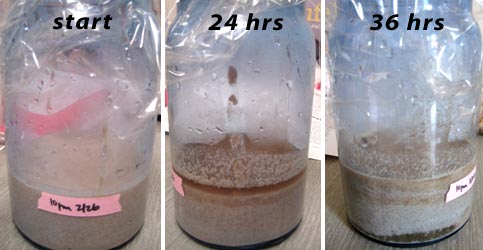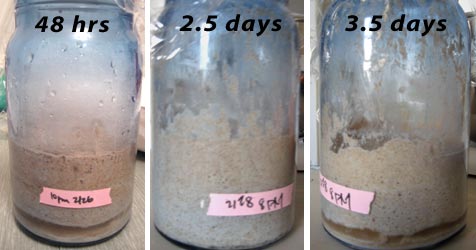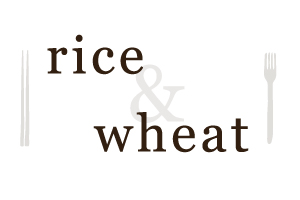I have a giant list of projects I keep saying I’ll do one day, but the truth is that list only seems to grow longer and never all that much shorter. Here are a few select items off that list: learn to crochet, make a bunch of pretty origami boxes for strings of Christmas lights (stolen idea after visiting a friend’s house), turn our coffee table into a light-table (joint project with Nathan), etc.
Last Tuesday, in an attempt to cross another thing off The List, I finally decided to stop talking about starting a sourdough starter and actually do it. After sifting (ha! get it?) through my cookbooks, the forums over at The Fresh Loaf and multiple random websites courtesy of Google, however, I was filled with contradictory advice and information. Should I use white flour, wheat flour, or rye flour? How often do I need to feed the starter? Do I need to use bottled water? Can I stir with a metal spoon? Do I need to use a kitchen scale to weigh out everything? Ahhh!
In the end, I had a revelation. Ok, maybe I shouldn’t call it a revelation yet since I haven’t proven that it actually works. So let’s say, I had an idea. Sourdough starters are not new; people have been making them for a long time, probably long before kitchen scales and measuring cups were common. This leads me to believe that you probably don’t need super-exact measurements to get one going. So I just went for it.
I grabbed a cup of whole-wheat flour and mixed it with a cup and a bit of warm water (Brita-filtered from the tap), making a “batter” that’s like thin pancake batter. I poured it into a glass jar, loosely covered the top with plastic wrap, marked the level with tape, and left it on the kitchen counter.

After 24 hours, I saw a layer of dark liquid on top, which is apparently called the ‘hooch’. Another 12 hours later, the hooch had settled to the bottom of the jar.

You can see in the pictures that after 48 hours total, the starter had risen quite a bit. At this point, I did the first feeding – which just meant pouring out half of the starter and mixing the leftover with another ½ cup of warm water and a little less than ½ cup of whole-wheat flour. You can probably use white flour too, but I have this huge bag of wheat flour in the fridge, so I thought I’d go crazy and use more wheat. The starter after this first feeding was a bit thicker than what I started with two days ago.
Another 12 hours later, the starter had risen more again and by 3.5 days, more hooch. Up to this point, the starter smelled mostly like fresh, yeasty dough. There were also bubbles inside the starter and the top surface was slightly foamy and bubbly.
(To be continued…)








